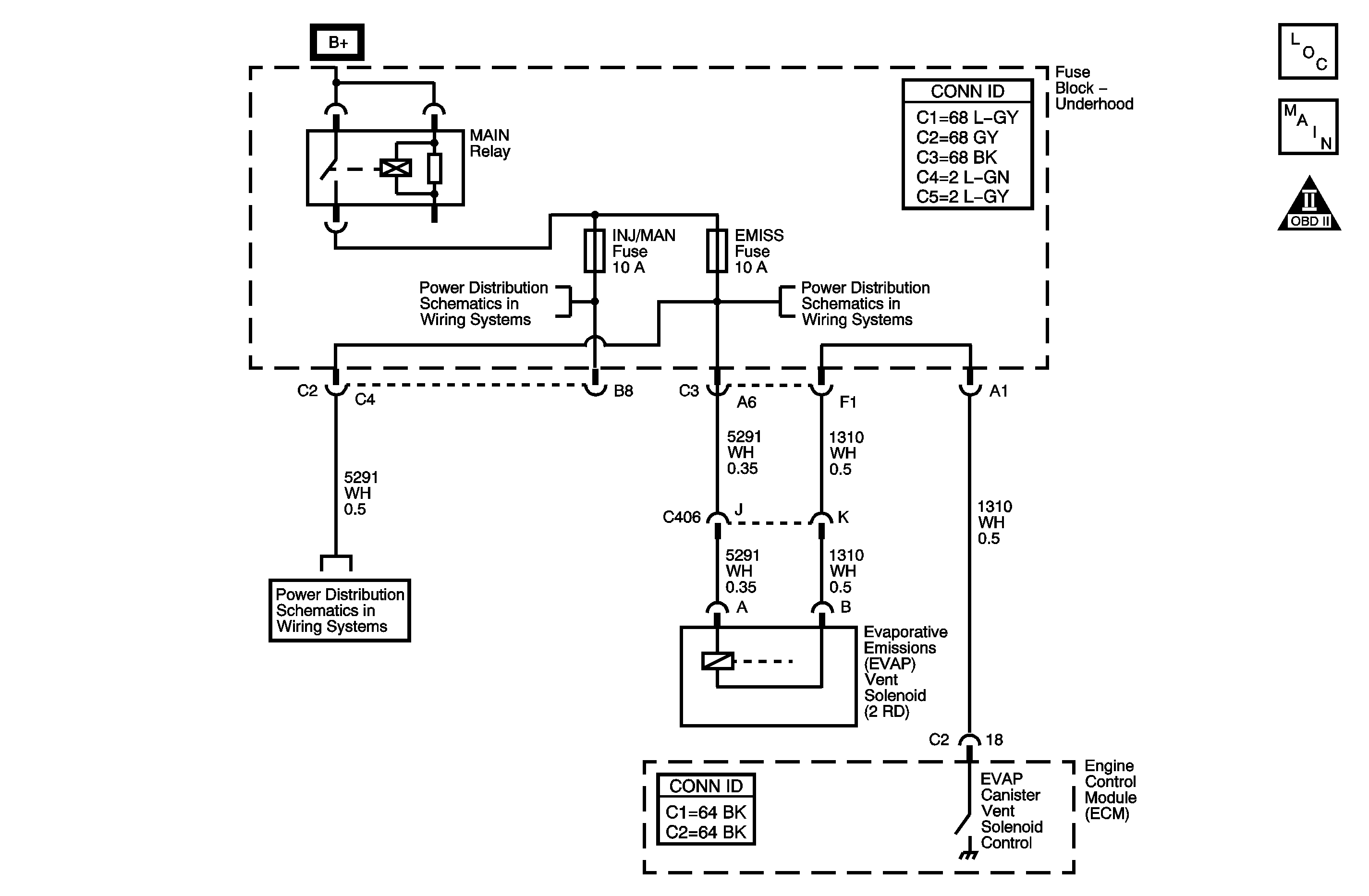
Circuit Description
An ignition voltage is supplied directly to the evaporative emission (EVAP) canister vent solenoid. The control module grounds the EVAP canister vent solenoid control circuit to close the solenoid by means of an internal switch called a driver. The scan tool displays the commanded state of the EVAP canister vent solenoid as ON or OFF. The control module monitors the status of the driver. If the control module detects low voltage on the control circuit when the driver is commanded OFF, this DTC sets.
The following table illustrates the relationship between the ON and OFF states, and the OPEN or CLOSED states of the EVAP canister vent solenoid.
Control Module Command | EVAP Canister Vent solenoid Position |
|---|---|
ON | CLOSED |
OFF | OPEN |
Conditions for Running the DTC
| • | The engine speed is more than 40 RPM. |
| • | The system voltage is between 8-18 volts. |
Conditions for Setting the DTC
| • | The control module detects less than 2.6 volts on the control circuit when the driver is commanded OFF. |
| • | The fault is present for 0.5 seconds. |
Action Taken When the DTC Sets
| • | The control module illuminates the malfunction indicator lamp (MIL) on the second consecutive ignition cycle that the diagnostic runs and fails. |
| • | The control module records the operating conditions at the time the diagnostic fails. The first time the diagnostic fails, the control module stores this information in the Failure Records. If the diagnostic reports a failure on the second consecutive ignition cycle, the control module records the operating conditions at the time of the failure. The control module writes the operating conditions to the Freeze Frame and updates the Failure Records. |
Conditions for Clearing the DTC
| • | A current DTC Last Test Failed clears when the diagnostic runs and passes. |
| • | A history DTC clears after 40 consecutive warm-up cycles, if no failures are reported by this or any other non-emission related diagnostic. |
| • | Clear the DTC with a scan tool. |
Diagnostic Aids
| • | The EVAP vent solenoid resistance is 18-27 ohms. |
| • | For intermittent conditions refer to Intermittent Conditions . |
| • | Listen for a click when the solenoid operates. Ensure that both the ON and the OFF states are commanded. Repeat the commands as necessary. |
Step | Action | Yes | No |
|---|---|---|---|
Schematic Reference: Engine Controls Schematics Connector End View Reference: Engine Control Module Connector End Views or Engine Controls Connector End Views | |||
1 | Did you perform the Diagnostic System Check-Engine Controls? | Go to Step 2 | |
2 |
Do you hear or feel a click from the EVAP vent solenoid when the solenoid is commanded ON and OFF? | Go to Step 3 | Go to Step 4 |
3 |
Did the DTC fail this ignition? | Go to Step 4 | Go to Diagnostic Aids |
4 |
Does the test lamp illuminate? | Go to Step 5 | Go to Step 7 |
5 | Test the control circuit of the EVAP vent solenoid for a short to ground. Refer to Testing for Short to Ground and Wiring Repairs in Wiring Systems. Did you find and correct the condition? | Go to Step 9 | Go to Step 6 |
6 | Test for an intermittent and for a poor connection at the control module. Refer to Testing for Intermittent Conditions and Poor Connections and Connector Repairs in Wiring Systems. Did you find and correct the condition? | Go to Step 9 | Go to Step 8 |
7 | Repair the ignition 1 voltage circuit of the EVAP vent solenoid for a short to ground. Refer to Circuit Testing and Wiring Repairs in Wiring Systems. Replace the fuse as necessary. Did you complete the repair? | Go to Step 9 | -- |
8 | Replace the control module. Refer to Engine Control Module Replacement . Did you complete the replacement? | Go to Step 9 | -- |
9 |
Did the DTC fail this ignition | Go to Step 2 | Go to Step 10 |
10 | Observe the Capture Info with a scan tool. Are there any DTCs that have not been diagnosed? | System OK | |
